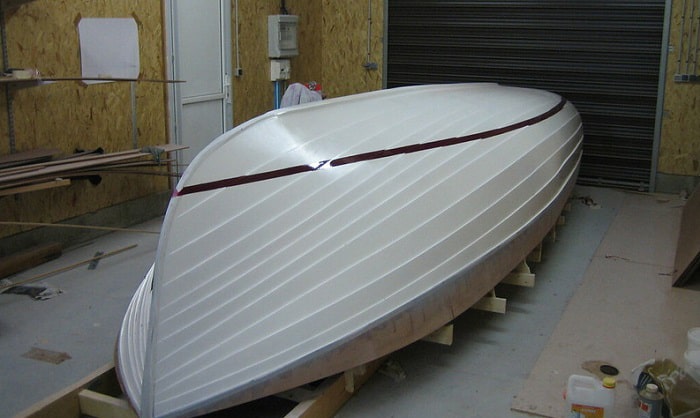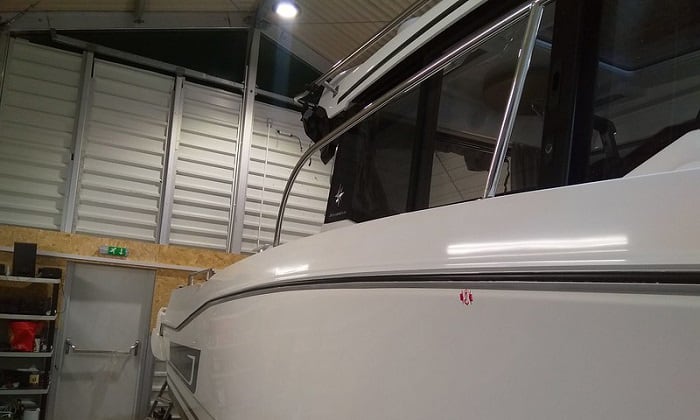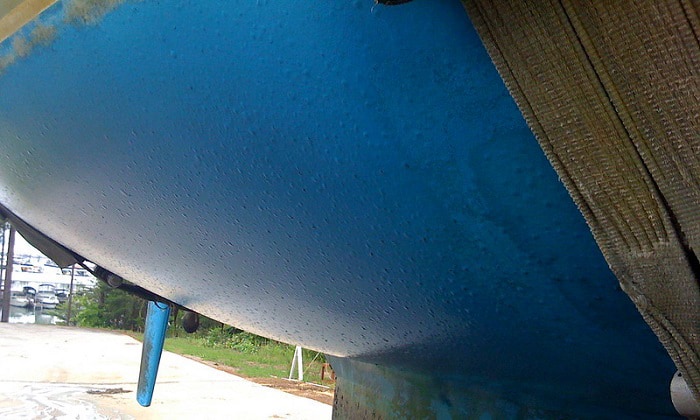Ever wondered why a large majority of boats have shiny polished hulls and decks that can withstand the elements? That question, quite ironically, already gives you the answer to the other, main question on your mind, “What is gelcoat on a boat?”
Gelcoat in the context of boats will always be associated with the high-quality finishes it imparts. It’s made of thick polyester resin or epoxy that protects the boat against scratches and other minor damage and lends it a shiny exterior. Although durable, it does need to be maintained consistently for its attractive finish to last.
Table of Contents
Gelcoat Explained
To the unfamiliar, gelcoat is often construed as the outer layer on a boat’s exterior. But besides knowing what is gelcoat made of, as I’ve already answered above, you need to know its other essential qualities.
This includes how thick it is, its typical hues, the surfaces and materials compatible with it, how it protects vital parts such as the hull, and its role in repairing damages to the boat.
- It’s typically onlysuitable for composite materials like fiberglass. It may adhere to aluminum surfaces with the right preparations, but don’t expect it to stick or last for long, as it undergoes oxidation the moment you apply it.
- The resin it’s made of is naturally water-repellent and UV light-resistant.
- How thick is gelcoat on a boat? On average, it’s 0.5 mm thick, making it a whole lot thicker than most finishes like standard boat paint.
- Most vessels nowadays come with gelcoats, and this is because manufacturers are capitalizing on the natural strength, better space, and cost-savings of fiberglass.
Why (Almost) Everyone Loves Gelcoat
Just hang out in various boating circles and sailing forums online, and it won’t take long for you to see why gelcoat for boats’ restoration is a crowd favorite. Sure, there will always be passionate paint purists out there, but they’re only equaled by the numerous gelcoat lovers worldwide.
Here’s why:
- The one standout quality that plenty of sailors can’t get enough of is how tough these finishes are. They can withstand the harsh weather environments your vessel is frequently subjected to – all while keeping that inimitable, eye-catching finish.
- Certain well-recognized brands like TotalBoat are tireless when it comes to improving their gelcoat offerings. Their ISO/NPG gelcoats, in particular, have been engineered to be more durable and flexible than other conventional incarnations of this particular finish.
- In the event that the fiberglass hull gets damaged and now has a hole that might compromise your safety while out in the water, you can easily use a gel coat sealant to patch it up.
If you have the time or ever encounter this problem, I suggest watching the video series prepared by BoatworksToday on Youtube. Here’s part one:
The Great Gelcoat and Paint
When it comes to refinishing or restoration time, many boat owners, especially those who are still testing the waters (literally and figuratively) face the dilemma of weighing the difference between gelcoat and paint. While I did highlight a number of compelling gelcoat perks above, it’s not exactly a one-sided battle.
In fact, I can safely say that paint may be the better option unless you’re going for a re-gelcoat job. For your easy reference, I’ve outlined the unique perks and qualities of gelcoat and paint in these points of comparison.
- Gelcoat is more porous than paint. Hence, it may take in dust, dirt, and other unwanted materials, leading to fading and loss of shine. It stains quickly and regular maintenance is often the only answer.
- Generally, paint is easier to apply on a large-scale repair project. The same can’t be said for gelcoat, which is typically more suitable for smaller repair jobs because it is hard to spray or apply in general.
- Many prefer gelcoat for fiberglass simply because it’s made specifically for the said material. Most modern sailboats are made of fiberglass, so the marriage between the two is pretty much a given.
- Gelcoat wins in overall protective capability, and this is why some boat owners choose to re-gelcoat instead of painting their vessels when restoring.
- Although most gelcoat products don’t offer much variety in color options, that’s not the case for repair kits, which give you numerous tints to choose from. The options vary enough to match most boats’ hues.
- As for repair costs, gelcoat may cost a lot more. This is why most experts encourage frequent preventive maintenance on a boat’s gelcoat to make sure it lasts long.
- On the other hand, paint can be touched up far more quickly and easily. Some gelcoat finishes are prone to scratches and blisters like the one shown here:
Are you planning to restore your boat’s gelcoat film or simply want to know how a standard can of gel coat is applied? If yes, I recommend reading this article on the top-rated Gelcoat restorers for boats, too.
If I’m going to weigh all the pros and cons, I would dissuade applying gelcoat in a paint-like fashion and as a topcoat because of its porous quality and risk of failing to adhere to the material it’s applied to. It will always be best for its primary purpose, which is molding.
Also, check this Gelcoat vs marine paint comparison to know more!
Conclusion
So, to wrap things up, what is gelcoat on a boat? It’s the smooth, shiny, and protective finish that glams up your average sailboat or even fishing vessel.
You better be prepared to put in the elbow grease to maintain it, though. On the whole, it’s tied with paint as far as pros and cons go, but the latter is easier to apply if the intent is restoration.

“My intention from the first day establishing Boating Basics Online is to provide as much help as possible for boaters who want to experience a first safe and convenient trip. So feel free to join us and share your beautiful journeys to the sea!”



